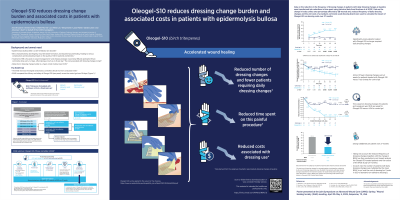Clinical Research
(CR-010) oleogel-s10 Reduces Dressing Changes Burden and Associated Costs in Patients with Epidermolysis Bullosa

Epidermolysis bullosa (EB) is a severe genetic disorder affecting epithelial integrity, primarily managed through frequent wound dressing changes. The EASE study demonstrated accelerated wound healing for Oleogel-S10 (birch triterpenes)* in EB (NCT03068780). This analysis evaluated the impact of Oleogel-S10 on dressing change frequency, time spent and associated costs in patients requiring daily dressing changes at baseline.
Methods:
EASE enrolled 223 patients with dystrophic or junctional EB randomized to receive Oleogel-S10 (n=109) or control gel (n=114) with standard dressings. Here, a post hoc analysis focused on patients with daily dressing changes at baseline and, using historical data, time spent and saved on dressing changes was calculated.
Results:
Among the subset of patients with daily dressing changes at baseline (Oleogel-S10 n=47, control gel n=53), 35.6% receiving Oleogel-S10 experienced reduced requirements by Day 90, compared to 10.6% receiving control gel. Oleogel-S10 resulted in a mean reduction of 1.36±0.24 weekly dressing changes, significantly more than control gel (0.41±0.23 fewer; difference –0.95±0.33; p=0.005). This translated to almost three fewer dressing changes every two weeks for Oleogel-S10 versus nearly one change for the control gel. Estimated time saved on dressing changes per week for the daily change cohort was 10.9h for Oleogel-S10 (6.6h for patients and 4.4h for caregivers) versus 4.0h for the control gel (2.4h for patients and 1.6h for caregivers), with a trend to cost savings in favor of Oleogel-S10.
Discussion:
Oleogel-S10 significantly reduced dressing change frequency compared with control gel, potentially alleviating the burden of dressing changes and associated costs.

.jpg)